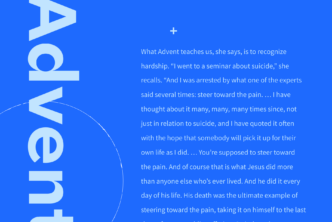If I thought I was a pretty scintillating Bible teacher, the kind that makes people sit on the edge of their seats, the kind that is also able to put the cookies on the lower shelf and interest even kids, that thought was shattered when my own kids got old enough for family devotions (age 2). You have never seen such bored kids, kids achieving new and powerful levels of bored. I confess that this caused no small level of frustration for me. Nothing tests my sanctification more than trying to promote theirs.
But what good is all the stuff I learn about the Bible in my extensive Logos Bible Software library if I can’t teach any of it to the three little people in the world whom I love most?
And at Christmas, I feel extra pressure: candy canes, presents, and Rudolph are fun, but how do I stoke wonder and even excitement about what we’re actually celebrating, one of the most precious Christian truths, the incarnation?
After some trial and error, and error, and error, and error, and a few times basically giving up, I’ve been having “Bible time” with the kids with reasonable consistency for a good while now.
Here’s what I can share for having meaningful Christmas family devotions.
1. Use pictures.
My two oldest kids, six and five, love reading. They love being read to. They will listen to a bedtime story—even one without pictures—for half an hour and beg for more. But they won’t listen to portions of the Bible without pictures. With even one picture to hold their gaze, they’ll do it, and do it well. I honestly don’t know why this is; ask a child psychologist. I think my kids are normal. I do not “blame” them for this need.
I do blame myself a bit. I’ve heard that other fathers succeed in reading the Bible text directly to their children, even starting in Genesis and making it to Revelation after a year or two. I want my kids to hear direct Bible, not just already-been-chewed Bible. When I attempted something like a sustained read-through, however, it failed. I feel I have to wait till they’re a little older. Right now, I don’t dare forget to use a picture. (I’ll even confess to occasionally using the amazing Bible Project videos.)
2. Keep it incredibly brief.
Ideally, Christian families would delight to spend an hour each night going through Scripture, singing psalms, and praying together. I gather that in Richard Baxter’s day they were doing this in his town of Kidderminster. I don’t have the wisdom to know why this is not reality for me today, but it just isn’t. Maybe that’s exactly what I should be doing. But my gut and/or conscience is that an hour a night would be too heavy a burden for my kids. I don’t want to violate Christ’s command to “suffer the little children” to come to him. I fear tying a heavy burden on them that even I cannot lift—how often do I spend an hour of my free time in the evening on devotional exercises?
A friend of mine still resents the drawn-out family devotions his (otherwise excellent) father insisted on dragging the family through every night. Armed with that knowledge, I started family devotions when the kids were little with something like a fifteen-minute expectation. That has shrunk to about five, though I’m happy to let it grow to ten or fifteen or more if the kids get engaged.
At first I fought the kids, I threatened and cajoled to reach the fifteen-minute mark. But that only made me (true confessions) so angry and on edge that I didn’t want to do family devotions at all. Right now—and I welcome wisdom from readers—my main goal is to do something most nights. And I’ve found that a relatively small diminution of my expectations has almost completely eliminated the need for threats and cajolements. My kids actually enjoy Bible time; maybe we can build on this. My goals are to fill their heads and, by God’s grace, stir their hearts. So that enjoyment is key.
3. Find a time that really works, and stick to it.
It sounds so unspiritual, but the main thing I’ve done which has brought me the most success is simple: I found the one time that really worked for us, and I stuck to it.
Kids, mine at least, feel safe in routine. I have read a bedtime story to my kids every single night for pretty much their entire sentient lives and I realized that “after dinner” or “at breakfast” are rather variable time slots, whereas bedtime happens every night at the same time. I came to see that to achieve success I had to attach family Bible time to this rock in our daily schedule.
So we read a story together, and then we pull out a children’s Bible (with pictures) and do a little reading. Then we brush teeth, I sing separate lullabies, and I field one question of any kind. Then ZZZZZ. Bible time is an accepted, standard part of our schedule. You’ll know you’ve reached that point when you forget it one night and the kids spontaneously protest.
4. Ask the kids one question of recall.
The family devotional Bible I’m using now includes two or three brief questions after each reading. Sometimes they are recall questions (the lowest level of Bloom’s taxonomy), and this is totally appropriate: I want to know if my kids grasped the details of whatever story or passage we just read.
Processing the basic facts of a story is an important step; it’s the first step toward trust and obedience of that passage.
5. Ask the kids one question of understanding.
But I don’t want to stop there—it wouldn’t be letting my kids come to Jesus if I satisfied myself with recall. I want to go at least to the next of Bloom’s steps: understanding. The Bible I’m using helps me do this. But I’m always happy when the kids do it on their own, as they sometimes will do once discussion begins. They can sometimes ask profoundly good questions. That is very satisfying, even when I have to utter a quick, silent prayer for wisdom because I don’t know quite how to answer. Occasionally Almighty Dad says, “I don’t know. I’ll check.” That’s okay, even good.
6. Ask the kids one question of application.
I also, ideally, help the kids apply the Bible to their lives—to see how its authority ought to function for them. This isn’t always possible or even desirable. I have concluded that it is acceptable for the proper application of some passages to be “know this Bible fact.” I don’t have to relate the story of Jonathan and his armor bearer directly to their lives right now. It’s enough that I’m building up the story of the Bible and pointing the kids little by little to the perfect Prophet, Priest, and King at its center.
7. Pray.
Have your kids pray. Ask them in advance to pray for one thing above and beyond the stock phrases that begin to fill their prayers before you know it (“thank you for this day”). I have even asked them to pray again, like it’s practice: “Sweetheart, pray for one thing you want God to do for someone you love. Try again.”
I used to be nervous about having my kids pray, because I didn’t want to push them into spiritual hypocrisy. I didn’t want to train them to talk to a God they didn’t really love or believe in. (And even now, if they ever express an unwillingness to pray, I don’t push them—because what do forced prayers do for a little soul?)
But I have concluded that Deuteronomy 6:6–7 knows better than I do. Though it doesn’t specifically tell me to teach my kids to pray or to have them pray, it tells me not to be worldview-neutral (as if that were possible) while I raise them. Like it or not, these kids got me as their dad and they’re going to be shaped by my love for the Lord and the Bible. I believe this means teaching them spiritual disciplines, not just intellectual truths—because biblical faith is designed to be embodied in practices as well as to be received in a list of doctrines.
8. End with a song. Let them alternate picking the song.
We sing the Doxology to end pretty much every Bible time (“Praise God from whom all blessings flow . . . ”) But sometimes I do also let the kids pick a song. They like it. My main job is to remember whose turn it is, lest Bible time become UFC.
One of my pastors used to make up little Bible songs for his kids. He’d take a verse right out of Scripture, put a little tune to it, and teach it to his kids. When he started up a long-term weekly ministry to impoverished kids and teens that I was a part of, he taught those same songs to them. Now there are hundreds of young people (up to about age 30) in Greenville, South Carolina, who know a bunch of Bible verses they wouldn’t know otherwise because of that ministry, and because of those songs. I’m reminding myself that I need to teach those to my own kids . . .
9. Use the NIrV. Maybe.
You don’t know how hard and how long I’ve struggled over what Bible translation to read to my kids. I’m not assuming anyone cares, but you may find it edifying to hear a tiny bit of my thinking on this.
On the one hand, I want my kids to understand as much of the Bible as possible. Both of my older kids, as I’ve said, are readers; but there’s no doubt that the NIrV (New International Reader’s Version) would be easier for them in many places than the NIV or CSB (Christian Standard Bible), let alone the ESV or NASB. I don’t want to put an unnecessary linguistic barrier between them and Jesus.
But on the other hand, my goal in reading the Bible to them is not merely a goal for the present but a goal for their future. I want them to have what I have: a memory of Scriptural words borne of lifelong exposure. I grew up on the KJV, and to this day, after 15 years spent reading other translations (though regularly using the KJV in exegesis), when I quote the Bible, the KJV comes out. My personal feeling is that my children are verbally proficient enough to skip the NIrV. I’m an inveterate explainer; I know when they don’t “get” a word in a literal translation, and I’ll stop and make sure they understand. (I also sometimes make a translation easier on the fly, a habit I picked up when using the KJV.)
10. Use this bonus tip for Advent.
One of the children’s Bible storybooks we’ve used is the redemptive-historical treasure, the Jesus Storybook Bible. I was just informed that it has precisely 24 stories from creation to the birth of Christ. One per night for advent. Perfect.
Go and trial and error likewise
I love my kids so, so much. It is so, so cool to watch them grow and learn. I find their recent jumps in reading skill particularly fascinating. But parenting is the hardest thing I’ve ever done, far outpacing doctoral comprehensive exams and that time I had to get across the American border from Mexico without a picture ID. I frequently feel like I need wisdom injections. I am not the best model for family devotions. I can only pray that the Lord will bless my meager efforts and that my kids will turn out okay despite my failures. Being humbled is good.
***






